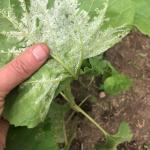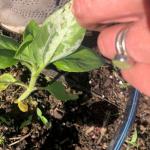Downy mildew was reported on sunflowers in Eastern Massachusetts this week. This disease is quite distinctive. Symptoms begin as angular yellow spots on the leaf surface. The fuzzy white sporulation of the causal organism (Plasmopara halstedii) is seen on the undersides of leaves. These characteristics distinguish this disease from powdery mildew, which produces a powdery white growth on both upper and lower leaf surfaces.
P. halstedii can be soil-borne or seed-borne. Infection of roots causes a systemic infection within the plant that can lead to flower deformities. Spores produced on the undersides of leaves are blown by the wind onto uninfected plants and cause secondary infections that are not systemic. Disease development is favored by cool to moderate temperatures and humid conditions.\
The most important management tactic is to remove all infected plants and plant debris (including roots, as much as possible) and dispose of them in the trash. Ensure proper spacing of plants to increase air circulation and decrease humidity in the plant canopy. Protective fungicides such as copper products may be used to protect uninfected plants from infection but will not cure infected plants. Do not plant sunflowers in the same area every year. Downy mildew resistant varieties of sunflower are available, check with your supplier.
P. halstedii has also been reported on gerbera, rudbeckia, coreopsis, ageratum, and Xanthium (cocklebur); however, the virulence and host preferences of P. halstedii strains is unknown. Also monitor these plants for symptoms of disease development.
- Angela Madeiras, Extension Educator and Diagnostician, UMass Extension Plant Diagnostic Lab


